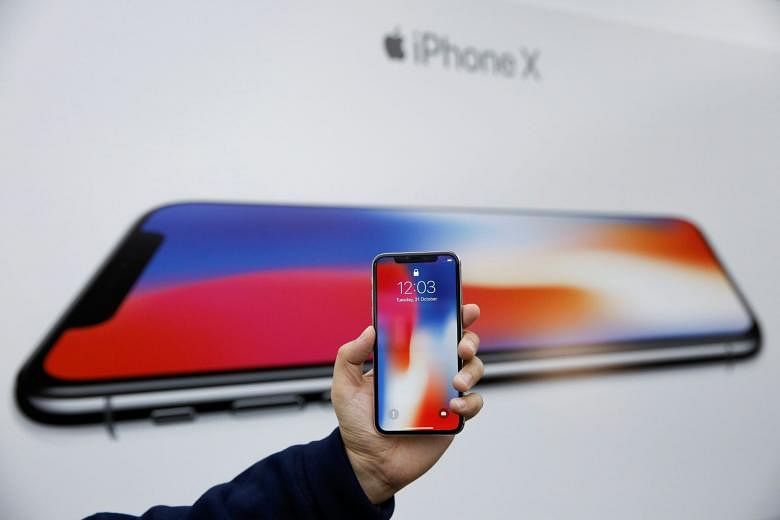This is still a review in progress. I only received the review unit of the Apple iPhone X (pronouned iPhone 10) on Monday this week, and so I'll focus on just a few key features: the new screen, Face ID (and the loss of the home button), Animojis and the heavily-criticised notch.
Unlike the iPhone 8 and 8 Plus, that look pretty much like their predecessors and the ones before them, the iPhone X marks the first major redesign in three years.
This is the first time an iPhone is using an organic light-emitting diode (Oled) panel. The iPhone X features a 5.8-inch Oled Super Retina HD display that covers almost its entire front.
The 2,436 x 1,125-pixel display looks absolutely gorgeous and super sharp. It is also a True Tone display like those of the iPad Pros, meaning it will automatically change the colour temperature of the display to suit the environment, making it easier on the eyes.
Despite its larger display, the iPhone X feels smaller and lighter than the recently-launched iPhone 8 Plus. The smaller size means better one-hand operation and it fits my jeans pocket much better than my iPhone 7 Plus.
Now on to the biggest change: Face ID. Touch ID, or Home button, is gone. Instead, the iPhone X uses a front-facing TrueDepth camera system that comprises a dot projector, infra-red camera, flood illuminator and a front-facing camera, to map and recognise a user's face. You use this face recognition, or Face ID, technology to unlock the phone.
Like previous iPhones, using a passcode is still the security priority. You need to set up a passcode first before you can set up Face ID.
Registering my face on the iPhone X was pretty quick. Two quick scans of my face by rotating my head slowly in a circular fashion, and my face was registered. You can only register one face to one iPhone X.
Once done, every time I lift the iPhone X to my face, the phone unlocks almost instantaneously. And I just need to swipe up from the display's bottom to get to the home screen.
I tried different scenarios with Face ID, such as holding the phone at a lower position, using the phone in the dark, having my sunglasses on, putting on a cap and adding some fake "Santa Claus beard". And it worked every time.
But Face ID seems to have a slight delay of around 1sec in dim lighting conditions. And no, it did not work when I used a picture of myself, closed my eyes, cupped my mouth and put my face really close (around 5cm) to the phone.
The TrueDepth camera also enables animated emoji, or Animoji, that you can create and send to your friends in iMessage. It captures and analyses over 50 different facial muscle movements to animate those expressions in a dozen different Animojis, including a panda, unicorn and of course poo.
It records your voice as well, so your friends get the full experience of voice and expressions. But each Animoji lasts at most 10sec. And while you can save the Animoji and send it to your friends in WhatsApp or Telegram, you have to first send it to someone on iMessage to do so. Hopefully, in the future, one can at least save an Animoji to the camera roll.
Perhaps, the one big drawback of all these changes to the iPhone X is having to re-learn all the gestures that iPhone users have in their muscle memory on how to operate an iPhone.
For example, you need to swipe up from the display's bottom to return home. As a result, to access Control Centre, you no longer swipe up but swipe down from the top-right edge of the display. For multi-tasking, you have to swipe up from the display's bottom and pause around the middle of the screen to activate the app switcher.
That said, I found myself getting used to these new gestures within 10min of using the iPhone X.
It is the same with the "notch" - a term coined by media to describe the black area on top of iPhone X's screen that houses the TrueDepth camera system. Some find the notch to be a serious design flaw. But while it would be nice to have a clean rectangular, edge-to-edge display, I got used to the notch in a matter of minutes.
You do lose screen space with that notch when playing some games or using some apps. But it's not a deal-breaker.
Instead, most of the issues I have found so far have more to do with the software.
For example, there is no option to display the battery percentage on the right side of the notch. There is also no way to display the AM and PM option of the clock, which is sited on the left side of the notch. That said, I do not know if it is due to the notch that some items cannot be displayed.
In addition, some games and apps are still not scaled to the new display's resolution, but only at the full high-definition resolution of 1,920 x 1,080 pixels.
Considering the current version of the Apple mobile operating system is iOS 11.0.3 and given that iOS 11.1 is launching soon, it is rather surprising to find that this review unit is loaded with an older iOS 11.0.1. And this review unit could not be updated. I hope some of the quirks I have found will be rectified with the iOS 11.1 update.
The iPhone X (from $1,648) will be available this Friday, Nov 3, at 8am in Apple's Orchard Road store and from other Apple resellers.
Stay tuned for the full review in next Wednesday's Digital in The Straits Times.


